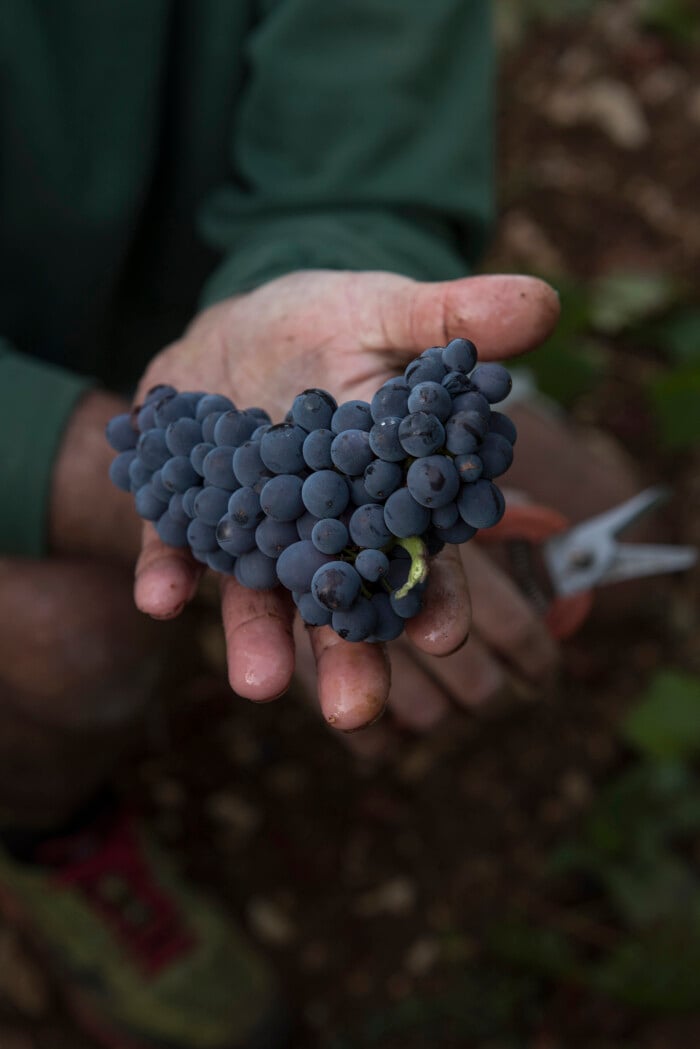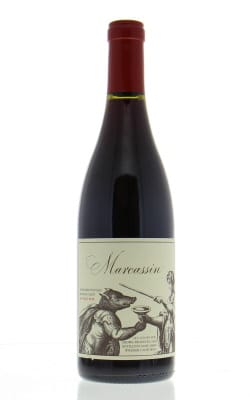
Pinot Noir
This is one of the most difficult grapes to cultivate, because of its demands for a certain (cool) climate, soil composition and growing conditions. But if all the conditions are met, the best red wines in the world can be made. The Pinot Noir grape, also known as Spätburgunder in wines from Germany, with its softness, subtlety and fruitiness, is nearly opposite to the rigidity and power of the Cabernet Sauvignon grape. The colour of pinot noir wines is much lighter than that of wines made from most other blue grapes.
Taste
Typical of pinot noir wines is the sheer fruitiness, in which red fruit (raspberry, strawberry) predominates. In addition, floral elements (violet, rose) and in the older (matured) wines earthy and animal tones like leather and truffle can become present.
The history of the Pinot Noir grape: where does it come from?
It is not only the epicentre of Pinot Noir, but also the home of the red grape: French Burgundy. The Romans were already growing wine here. And it is assumed that the ancestors of Pinot Noir date back to this time. Incidentally, the name ‘Pinot Noir’ is derived from the French word ‘pin’ (pine), which refers to the shape of the grapes, which resemble a pine cone.
For a long time, little was heard about Pinot Noir in Burgundy. It was a grape that was simply grown. But in the Middle Ages, two remarkable things happened. At that time, there was another star among the red grape varieties in Burgundy. Namely Gamay. The grape was wonderfully easy to grow and produced charmingly fruity wines. But Philip the Bold, Duke of Burgundy, banned Gamay from Burgundy by decree on 31 July 1395. In his opinion, the grape was ‘not beneficial’.
Without Gamay, the monks then concentrated on Pinot Noir. Yes, in those days almost all vineyards in Burgundy were cultivated by different monasteries. The monks perfected viticulture and laid the foundation for such famous vineyards as Vosne-Romanée and Gevrey-Chambertin. Burgundy became the centre of Pinot Noir cultivation. The wines were enjoyed by almost all European kings!
Pinot Noir worldwide
From Burgundy, Pinot Noir gradually conquered the world from the 19th century onwards. It was first cultivated in Champagne and other European countries such as Germany (as Spätburgunder), Austria and Italy. In the mid-19th century, emigrants took the grape variety with them overseas. And they did so mainly to New Zealand, Australia and the United States.
In the United States, Pinot Noir quickly became a central component of the wine industry in the course of the 20th century. In California, it is mainly the cooler regions such as Russian River Valley, Los Carneros and Santa Barbara County where the grape variety produces fantastic wines. In California alone, Pinot Noir is cultivated on 15,000 hectares of vineyards. In Oregon, especially in the Willamette Valley, there are another 5,000 hectares. Here, too, Pinot Noir produces unique wines of character.
A good 105,000 hectares worldwide are planted with Pinot Noir. France is the leader with 31,000 hectares – followed by 22,000 hectares in the USA. In third place, and this may come as a surprise, is Germany, with a good 11,000 hectares. In general, winemakers all over the world are trying to cultivate Pinot Noir. However, the conditions for this have to be almost perfect. But more about that later. The reason why the wine world is so crazy about Pinot Noir is the taste of the wines. That's why we'll look at this first to better understand the fascination.
What does Pinot Noir taste like?
Of course, there is no single Pinot Noir taste. After all, the grape variety is a true terroir grape that reacts very sensitively to soils and climate. Nevertheless, there are a few characteristics that can be found in almost every Pinot Noir. First, there are fruity notes of red fruits such as cherry, raspberry, strawberry and blackberry, which are mainly found in young wines. As a rule, floral notes of violet or rose are also added.
If the Pinot Noir was aged in wooden barrels, nuances of tobacco, vanilla or coconut are added. Do you notice a distinct hint of cinnamon? Then it is highly likely that the wine was made using the carbonic maceration method. And then there are the aged Pinot Noir wines, which can smell of mushrooms and forest soil and autumn leaves and truffles. Incidentally, Pinot Noir generally has very little tannin. This is precisely why it is extremely elegant and delicate on the palate. Incidentally, for optimal enjoyment, we recommend a drinking temperature of 16 to 18 °C.
What are the ideal growing conditions for Pinot Noir?
And here we have finally arrived at the reason why Pinot Noir is not grown everywhere in the world. The grape variety is a real diva! It doesn't like it too cold, but it also doesn't like it too warm. It needs sufficient water, but it also can't be too humid. Not to mention the fact that it also needs to be regularly nurtured and cared for during the growing season so that the winemakers can later harvest good quality grapes.
Pinot Noir thrives best in a cool to temperate climate. Sloping sites with calcareous soils also provide ideal conditions, as they store heat and are good at draining excess water. And if the site is also well protected from frost, then little can go wrong. At least if the winemaker relies on rigorous yield reduction so that the remaining grapes are well ventilated and the quality is ultimately good. As you can see, anyone who wants to grow Pinot Noir needs strong nerves and a lot of patience. And, of course, they need to be very lucky to have vines in the right place.
Which growing areas are known for Pinot Noir?
Pinot Noir truly does not thrive everywhere. But there are a few regions around the world that are virtually predestined for this demanding grape variety. And we will take a closer look at them now.
- Burgundy, France. The home of Pinot Noir is still the epicentre of the grape variety par excellence. The chalky soils, especially in the top vineyards of the Côte de Nuits, promote the minerality and complexity of the wines. In addition, the cool climate ensures that the grapes ripen slowly, allowing intense aromas to develop. The result is elegant and complex wines with aromas of red fruits, floral notes and earthy nuances.
- Champagne, France. In the French region of Champagne, conditions are similar to those in Burgundy. But there is a subtle difference. In Champagne, you find soils known as Kimmeridgean clay. These are particularly old and calcareous soils that bring a great deal of delicate elegance to the base wines for champagnes of all varieties.
- Willamette Valley, Oregon, USA. Oregon has a slightly warmer and wetter climate than Burgundy, but it is still similar enough for Pinot Noir to thrive here. The volcanic soils emphasise the acidity and minerality in the wines and provide a refreshing crispness. The result is wines with vibrant acidity, fruit flavours of cherry and cranberry, and subtle earthy notes.
- Sonoma Coast, California, USA. The proximity to the Pacific Ocean ensures cool nights and morning fog, which allows the grapes to ripen slowly. The soils are well-drained and enhance the intensity of the aromas. This is where fruit-forward wines with aromas of strawberries, cherries and spices, as well as a velvety texture, are produced.
- Central Otago, New Zealand. This region on the South Island of New Zealand offers a cool-climate terroir with intense sunlight and cool nights. The slate soils contribute minerality to the wines. Pinot Noir is used to make powerful wines with intense fruit aromas such as raspberry and blackberry, as well as a lively acidity.
- Ahrtal, Germany. The cool climate of the Ahr Valley produces delicate Pinot Noirs. The steep vineyards guarantee good sunlight, while the slate soils store heat. Together, this ensures light to medium-bodied wines with fine acidity and elegant fruit flavours.
Some of the best or most famous Pinot Noir wines
Domaine de la Romanee Conti

2019
€ 19.995,00 (ex Vat) € 24.193,95 (in Vat) more info
Marcassin

2002
sold out more info
Cedric Bouchard

2008
(Magnum) sold out more info
Rudolf Furst

2019
sold out more info
What food goes well with Pinot Noir?
Between you and me, Pinot Noir is one of the best food companions for more refined dishes when it comes to red wine. For example, light game dishes such as venison fillet, venison ragout or wild duck harmonise perfectly with the earthy and fruity notes of Pinot Noir. The same applies to poultry dishes such as duck, goose or chicken.
The earthy nuances of Pinot Noir are also an ideal match for mushroom dishes such as truffle risotto, porcini ragout or pasta with mushrooms. And braised or roasted lamb, pork fillet or beef is perfectly complemented by the soft texture and fine acidity of Pinot Noir. It goes particularly well with spicy sauces. Mild to medium-strong cheeses such as Brie, Camembert or Epoisses also harmonise perfectly with Pinot Noir. The wine emphasises the creamy texture and flavour of the cheese. Hearty dishes such as roasts, venison burgers or raclette also go well with a classic Pinot Noir.
Three fun facts about Pinot Noir
- The film ‘Sideways’ triggered a boom in Pinot Noir wines in 2004 because the protagonist had a great weakness for the grape variety. Since then, the steep sales curve of Pinot Noir in the USA has been called the ‘Sideways effect’.
- Pinot noir is highly mutational. It has given rise to numerous other varieties, including pinot gris and pinot blanc.
- Hardly any other grape variety has been and is optimised as much as pinot noir. In France alone, over 50 different clones have been selectively bred that differ greatly in yield, resistance and ripening behaviour.

